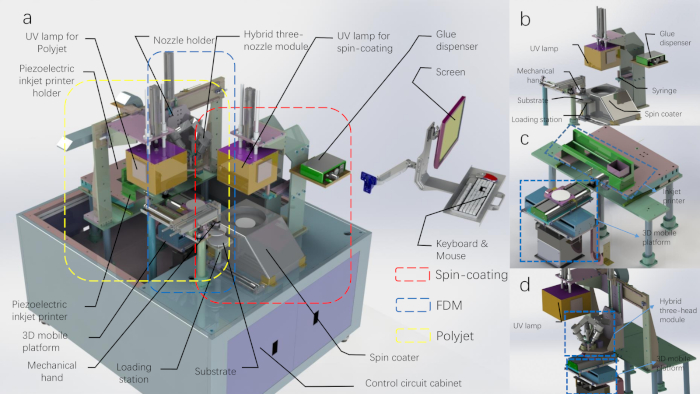生体組織をシミュレートするファントムのマルチモーダル3Dプリンティング
Summary
スピンコーティング、ポリジェット印刷、および融合蒸着モデリングが統合され、生体組織の構造的および機能的特性をシミュレートする多層異種ファントムを生成します。
Abstract
バイオメディカル光イメージングは、様々な疾患の診断・治療において重要な役割を果たしています。ただし、光学イメージングデバイスの精度と再現性は、そのコンポーネント、テスト環境、および操作の性能特性に大きく影響されます。したがって、これらのデバイスを追跡可能なファントム標準で校正する必要があります。しかし、現在利用可能なファントムのほとんどは、生体組織のマルチモーダルおよび動的特性をシミュレートできない均質なファントムである。ここでは、スピンコーティングモジュール、ポリジェットモジュール、融合蒸着モデリング(FDM)モジュール、および自動制御フレームワークを統合した生産ラインを用いた異種組織シミュレーションファントムの製造を示す。「デジタル光ファントム」の構造情報と光学パラメータは、プロトタイプファイルで定義され、生産ラインにインポートされ、異なる印刷モダリティ間のシーケンシャルスイッチを備えた層ごとに作製されます。このような生産ラインの技術的能力は、表皮、真皮、皮下組織、および埋め込み腫瘍を含む皮膚模擬ファントムの自動印刷によって例示される。
Introduction
バイオメディカル光学イメージングは、生体組織との光相互作用に基づいて疾患や組織異常を検出する医療画像ツールのファミリーを表します。磁気共鳴画像(MRI)やコンピュータ断層撮影(CT)などの他の画像化モダリティと比較して、生物医学光学イメージングは、低コストおよび携帯機器1、2、3、4を用いた組織構造、機能、および分子特性の非侵襲的測定を利用する。しかし、コストと携帯性において優れているにもかかわらず、光学イメージングは臨床診断や治療指導のために広く受け入れされておらず、その再現性が低く、光学的パラメータと生物学的パラメータ間の定量的マッピングが欠如しているため、一部は認められています。この制限の主な理由は、定量的なキャリブレーションと生物医学光学イメージングデバイスの検証のための追跡可能な基準の欠如です。
過去には、脳5、6、7、皮膚8、9、10、11、12、膀胱13、および乳房組織14、15、16、17などの様々な組織タイプの生物医学的光学画像研究のために様々な組織シミュレーションファントムが開発されました。これらのファントムは、主に以下の製造プロセスのいずれかによって生成されます:1)スピンコーティング10、18(均質および薄層組織をシミュレートするための)。2)成形19(幾何学的特徴を持つかさばる組織をシミュレートするための)。3)3次元(3D)印刷20、21、22(多層異種組織をシミュレートするための)。成形によって生成される皮膚ファントムは、皮膚組織のバルク光学特性を模倣することができるが、横光学不均一性19をシミュレートすることはできない。Bentzらは、生体組織23の異なる光学特性を模倣するために2チャンネルFDM 3D印刷法を用いた。しかし、2つの材料を使用すると、組織の光学的不均一性と異方性を十分にシミュレートすることはできません。Lurie et al. は、3D プリンティングとスピンコーティング13を組み合わせることにより、光コヘランス断層撮影(OCT)および膀胱鏡検査用の膀胱ファントムを作成した。しかし、血管などの幻影の異種特徴は手描きしなければならなかった。
上記のファントム製造プロセスの中で、3Dプリンティングは、生体組織の構造的および機能的異質性をシミュレートするための最も柔軟性を提供します。しかし、皮膚組織のような多くの生体組織タイプは、単一の3D印刷プロセスでは効果的に複製できない多層および多スケールのコンポーネントで構成されています。したがって、複数の製造プロセスの統合が必要です。バイオメディカル光学イメージングの追跡可能な標準として、ファントムをシミュレートする多層・多スケール組織の自動生産に複数の製造プロセスを統合した3Dプリンティング生産ラインを提案する(図1)。スピンコーティング、ポリジェット印刷、FDMは3Dプリンティング生産ラインで自動化されていますが、各モダリティは確立されたプロセスと同じ機能特性を保持します。したがって、本論文では、単一の装置における複数のプロセスの物理的統合を必要とせずに、多スケール、多層、および異種組織シミュレーションファントムを製造するための一般的なガイドラインを提供する。

図1:3Dプリント生産ラインのCAD図(A) 上部シェルを取り外した 3D プリントの生産ライン。(B) スピンコーティングモジュールとメカニカルハンドモジュールの概略図。(C) ポリジェット印刷モジュールの概略図。(D) FDM印刷モジュールの回路図(UVランプはポリジェット印刷モジュールに属する)。この図の大きなバージョンを表示するには、ここをクリックしてください。
Protocol
Representative Results
Discussion
多層ファントムの製造において、スピンコーティングに使用される材料は、PDMSの代わりに光硬化性材料の一種である。中間層は、光硬化性樹脂を原料として使用するポリジェット印刷方式で印刷されます。薄いPDMSファントムは、tert-ブチルアルコールを添加した後にスピンコーティングによって作ることができますが、PDMS層はポリジェット印刷中に光硬化性材料に効果的に結合することは?…
Divulgazioni
The authors have nothing to disclose.
Acknowledgements
この研究は、中国国立自然科学財団(Grant Nos. 11002139および81327803)と中央大学の基礎研究基金によって支援されました。科学技術大学のザカリー・J・スミス氏に音声ナレーションを提供してくださったことに感謝します。
Materials
| 2-Hydroxy-2-methylpropiophenone | aladdin | H110280-500g | Light initiator http://www.aladdin-e.com/ |
| 3D printing control system | USTC | USTC-3DPrinter_control1.0 | custom-made github: https://github.com/macanzhen/ |
| 3D printing system | USTC | USTC-3DPrinter1.0 | custom-made |
| AcroRip color | Human Plus | AcroRip v8.2.6 | |
| All-in-one nozzle slicing script | Shenzhen CBD Technology Co.,Ltd. | github: https://github.com/macanzhen/ |
|
| Chinese Red Dye | Juents | Oil-soluble | |
| Cura | Ultimaker | Cura_15.04.6 | |
| Gel Wax | Shanghai Lida Industry Co.,ltd. | LP | melting point: 56 °C |
| Graphite | aladdin | G103922-100g | Change object optical absorption parameters http://www.aladdin-e.com/ |
| PDMS | Dow Corning | 184 | |
| Titanium dioxide | ALDRICH | 24858-100G | 347 nm |
| Triethylene glycol dimethacrylate | aladdin | T101642-250ml | Photocured monomer http://www.aladdin-e.com/ |
| UV ink SLA Photopolymer Resin | time80s | RESIN-A | http://www.time80s.com/zlxz |
Riferimenti
- Lu, G., Fei, B. Medical hyperspectral imaging: a review. Journal of Biomedical Optics. 19 (1), 010901 (2014).
- Wang, K., et al. Development of a non-uniform discrete Fourier transform based high speed spectral domain optical coherence tomography system. Optics Express. 17 (14), 12121-12131 (2009).
- Zhao, H., Gao, F., Tanikawa, Y., Homma, K., Yamada, Y. Time-resolved diffuse optical tomographic imaging for the provision of both anatomical and functional information about biological tissue. Applied Optics. 44 (10), 1905-1916 (2005).
- Ding, Z., Ren, H., Zhao, Y., Nelson, J. S., Chen, Z. High-resolution optical coherence tomography over a large depth range with an axicon lens. Optics Letters. 27 (4), 243-245 (2002).
- Iida, H., et al. Three-dimensional brain phantom containing bone and grey matter structures with a realistic head contour. Annals of Nuclear Medicine. 27 (1), 25-36 (2013).
- Mobashsher, A. T., Abbosh, A. Three-dimensional human head phantom with realistic electrical properties and anatomy. IEEE Antennas and Wireless Propagation Letters. 13, 1401-1404 (2014).
- Li, J. B., et al. A new head phantom with realistic shape and spatially varying skull resistivity distribution. IEEE Transactions on Biomedical Engineering. 61 (2), 254-263 (2013).
- Bykov, A., et al. Multilayer tissue phantoms with embedded capillary system for OCT and DOCT imaging. Life Sciences. (International Society for Optics and Photonics). , 73760 (2011).
- Bykov, A. V., Popov, A. P., Priezzhev, A. V., Myllylä, R. Skin phantoms with realistic vessel structure for OCT measurements in Laser Applications. European Conference on Biomedical Optics. , 80911 (2010).
- Park, J., et al. Fabrication of double layer optical tissue phantom by spin coating method: mimicking epidermal and dermal layer. Design and Performance Validation of Phantoms Used in Conjunction with Optical Measurement of Tissue V. , 85830 (2013).
- Wróbel, M. S., et al. Use of optical skin phantoms for preclinical evaluation of laser efficiency for skin lesion therapy. Journal of Biomedical Optics. 20 (8), 085003 (2015).
- Sheng, S., Wu, Q., Han, Y., Dong, E., Xu, R. Fabricating optical phantoms to simulate skin tissue properties and microvasculature. Design and Performance Validation of Phantoms Used in Conjunction with Optical Measurement of Tissue Vii. , 932507 (2015).
- Lurie, K. L., Smith, G. T., Khan, S. A., Liao, J. C., Ellerbee, A. K. Three-dimensional, distendable bladder phantom for optical coherence tomography and white light cystoscopy. Journal of Biomedical Optics. 19 (3), 36009 (2014).
- Hahn, C., Noghanian, S. Heterogeneous breast phantom development for microwave imaging using regression models. Journal of Biomedical Imaging. 2012, 6 (2012).
- Ansari, M. A., Mohajerani, E. Estimation of optical abnormalities in breast phantom by diffuse equation. Optik-International Journal for Light and Electron Optics. 125 (20), 5978-5981 (2014).
- Roman, M., Gonzalez, J., Carrasquilla, J., Erickson, S. J., Godavarty, A. A Gen-2 Hand-Held Optical Imager: Phantom and Preliminary in-vivo Breast Imaging Studies. 29th Southern Biomedical Engineering Conference. , 103-104 (2013).
- Michaelsen, K. E., et al. Anthropomorphic breast phantoms with physiological water, lipid, and hemoglobin content for near-infrared spectral tomography. Journal of Biomedical Optics. 19 (2), 026012 (2014).
- Park, J., et al. Optical tissue phantoms based on spin coating method. Design and Performance Validation of Phantoms Used in Conjunction with Optical Measurement of Tissue VII. , 93250 (2015).
- Mustari, A., et al. Agarose-based tissue mimicking optical phantoms for diffuse reflectance spectroscopy. Journal of Visualized Experiments. (138), e57578 (2018).
- Luciano, N. J., et al. Utilizing 3D printing technology to merge MRI with histology: A protocol for brain sectioning. Journal of Visualized Experiments. (118), e54780 (2016).
- Dong, E., et al. Three-dimensional fuse deposition modeling of tissue-simulating phantom for biomedical optical imaging. Journal of Biomedical Optics. 20 (12), 121311 (2015).
- Beltrame, E. D. V., et al. 3D Printing of Biomolecular Models for Research and Pedagogy. Journal of Visualized Experiments. (121), e55427 (2017).
- Bentz, B. Z., Chavan, A. V., Lin, D., Tsai, E. H., Webb, K. J. Fabrication and application of heterogeneous printed mouse phantoms for whole animal optical imaging. Applied Optics. 55 (2), 280-287 (2016).
- Liu, G., et al. Fabrication of a multilayer tissue-mimicking phantom with tunable optical properties to simulate vascular oxygenation and perfusion for optical imaging technology. Applied Optics. 57 (23), 6772-6780 (2018).

